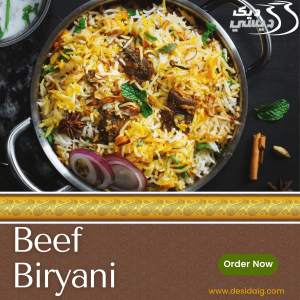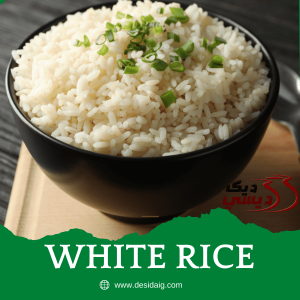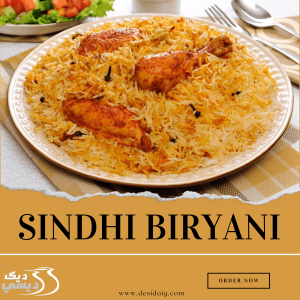Beef Biryani Daig
The tradition of Beef Biryani Daig is a splendid testament to the rich culinary heritage of South Asia, particularly Pakistan, where it stands as a symbol of communal harmony and festivity. Prepared in large pots, known as ‘Daig,’ this dish is a celebration of flavors, aromas, and the art of cooking. It’s a feast that transcends mere eating, turning meals into occasions and gatherings into celebrations.
The Essence of Beef Biryani
Beef Biryani is not just a dish; it’s an experience. It combines tender beef chunks marinated in an array of spices, layered with fragrant basmati rice, and cooked to perfection. The result is a symphony of flavors that dances on the palate, offering a taste of the land’s history, culture, and communal spirit.
Crafting the Perfect Marinade
The journey of creating Beef Biryani Daig begins with the marinade. A rich mixture of yogurt, biryani masala, ginger-garlic paste, green chilies, and a medley of spices infuses the beef with robust flavors. This marination process, often lasting several hours or overnight, ensures that the meat is tender, juicy, and richly flavored.
Layering: The Art and Science
The magic of Beef Biryani lies in its layering. Alternating layers of marinated beef and partially cooked rice are meticulously arranged in the Daig. Each layer is sprinkled with fried onions, mint leaves, saffron-infused milk, and dots of ghee, creating a mosaic of flavors and textures. This careful assembly is crucial for the biryani’s complexity and depth.
The Cooking Ritual
Cooking Beef Biryani in a Daig is a slow, deliberate process that allows the ingredients to meld together harmoniously. The Daig is sealed, often with dough, to trap the steam and aromas, ensuring that the rice cooks in the flavorful steam from the marinated beef. This method, known as ‘Dum’ cooking, brings out the richness of the spices and tenderizes the beef to perfection.
Serving the Feast
Beef Biryani Daig is not merely served; it is presented. Accompanied by sides such as raita, salad, and lemon wedges, it makes for a complete meal. The unveiling of the Daig is a ceremonial moment, as the aromatic steam escapes, revealing the beautifully cooked Biryani, ready to be shared and savored.
Nutritional Balance
While Beef Biryani is a hearty, indulgent dish, it also offers nutritional benefits. The beef provides high-quality protein, while the rice serves as a source of energy. The spices, apart from adding flavor, have various health benefits, making Biryani a dish that nourishes as much as it delights.
Conclusion
Beef Biryani Daig is more than a dish; it’s a cultural icon that brings people together. It embodies the spirit of Pakistani cuisine, reflecting the country’s love for food, family, and festivity. In every grain of rice and piece of beef lies the story of a tradition that has been passed down through generations, continuing to bring joy and togetherness to countless gatherings.
Beef Biryani
Beef Biryani daig has been a traditional dish since ancient times. However, the origin of beef biryanis is not known. There are many stories about its origins. The recipe of beef biryanis has changed over time, and different regions of India use their dish variations. In North India, however, beef biryanis are often prepared using mutton. In South India, but they are traditionally made using goat meat.
The most popular version of beef biryanis uses lamb instead of beef, however, lamb biryanis are called kambakkam biryani.
There are two types of beef biryanis – dry and wet. Dry beef biryanis are cooked without any liquid. On the other hand, wet biryanis are boiled in water.
Dry beef biryanis are usually eaten at breakfast or lunch, however, you can prepare them in advance and keep them in the refrigerator for several days.
Wet biryanis are usually served as a dinner dish, and you can make them ahead of time and serve them later.
Types Of Biryani
1. Beef biryanis consists of meat cooked in a rich sauce containing spices and vegetables, however, often rice is added to beef biryani. Traditionally, the meat is marinated overnight before cooking.
2. Chicken biryani is similar to beef biryani, therefore, chicken is substituted for beef in the recipe.
3. Lamb biryani is similar in preparation to beef biryani. However, lamb is substituted for beef.
4. Vegetable biryani is a variation of beef biryani or chicken biryani that includes vegetables instead of meat.
5. Mutton biryani is a variety of mutton curry that contains rice.
6. Fish biryani is a fish stew that uses rice.
7. Egg biryani is prepared with eggs, potatoes, and cauliflower.
8. Tandoori biryani is a tandoori chicken biryani spiced with cumin, coriander, turmeric, chili powder, and garam masala.
9. Korma biryani is a creamy version of tandoori biryani that is made using yogurt in place of cream.
10. Paneer biryani is a vegetarian alternative to tandoori biriyani that uses cheese instead of meat.
Ingredients
– 1 kg beef mince
– 2 onions chopped
– 1 teaspoon turmeric
– 1/2 teaspoon ginger garlic paste
– Cup coriander leaves 1/2
– 1/2 red chili pepper crushed
– Garam masala 1 tablespoon
– 1 teaspoon cumin seeds
– 1 teaspoon black peppercorns
– Salt to taste
– 4 cups basmati rice
– Oil for frying
– Water








There are no reviews yet.